Project Selection: Analytic Hierarchy Process (AHP) Literature Review
VerifiedAdded on 2020/04/13
|23
|6231
|69
Literature Review
AI Summary
This literature review explores the application of the Analytic Hierarchy Process (AHP) in project selection for portfolio design within the context of strategic project, program, and portfolio management. The review begins by highlighting the importance of effective strategies for organizational success and introduces the Strategic Framework Model, including the balanced scorecard, to illustrate how AHP can be integrated into business process improvement. It then delves into the advantages of using AHP, such as its hierarchical structure, ability to consider both qualitative and quantitative factors, and its role in resource allocation. The review outlines the AHP process, including the development of business criteria, determination of priorities, and resource allocation. It then examines project portfolio selection strategies, emphasizing the alignment of projects with corporate strategy and the use of financial indicators. The review also covers the systemic approach to project portfolio selection, the decision-making process supporting project selection, and the fundamentals of AHP, including its advantages and application in modern project portfolio management. The review concludes by summarizing the reasons for using AHP in decision-making processes.
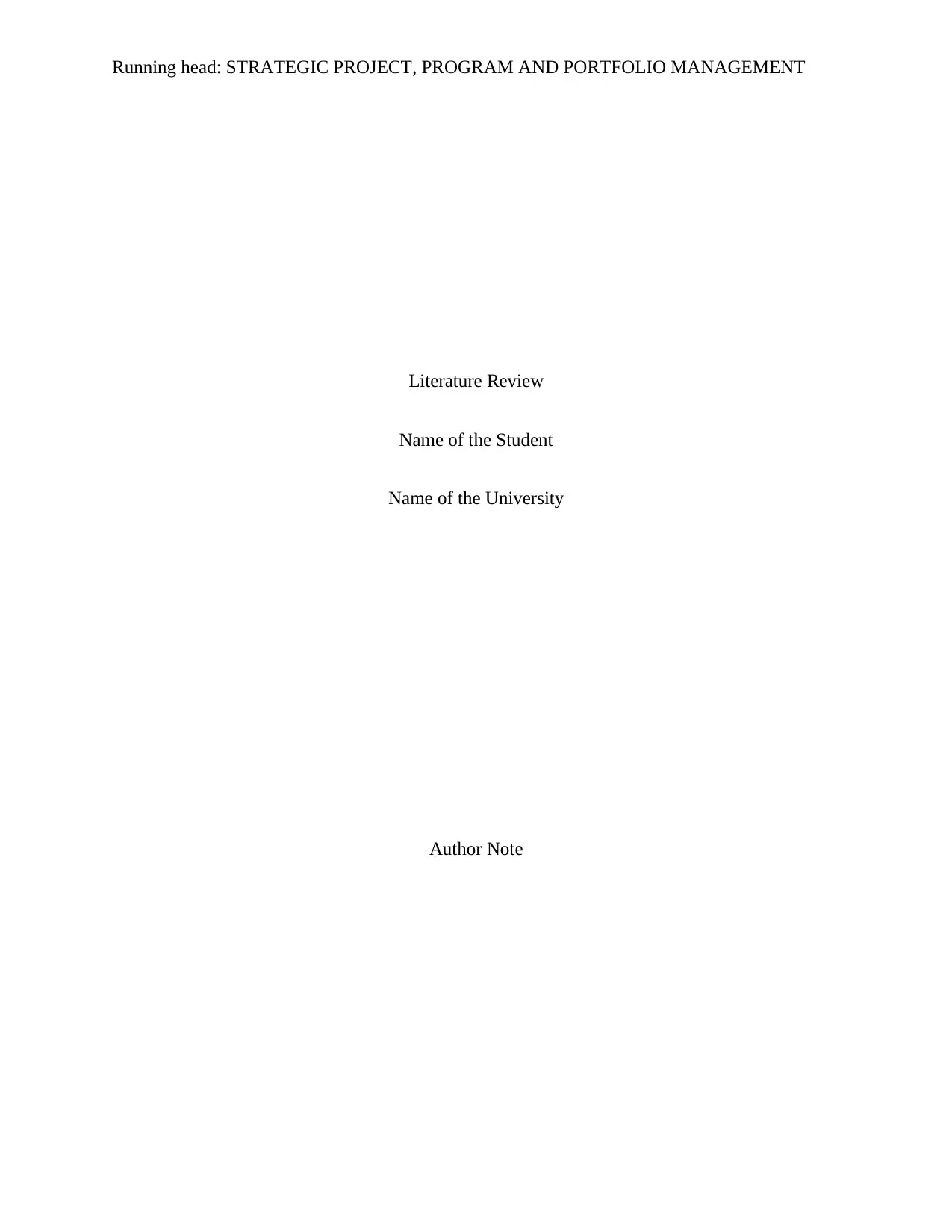
Running head: STRATEGIC PROJECT, PROGRAM AND PORTFOLIO MANAGEMENT
Literature Review
Name of the Student
Name of the University
Author Note
Literature Review
Name of the Student
Name of the University
Author Note
Paraphrase This Document
Need a fresh take? Get an instant paraphrase of this document with our AI Paraphraser
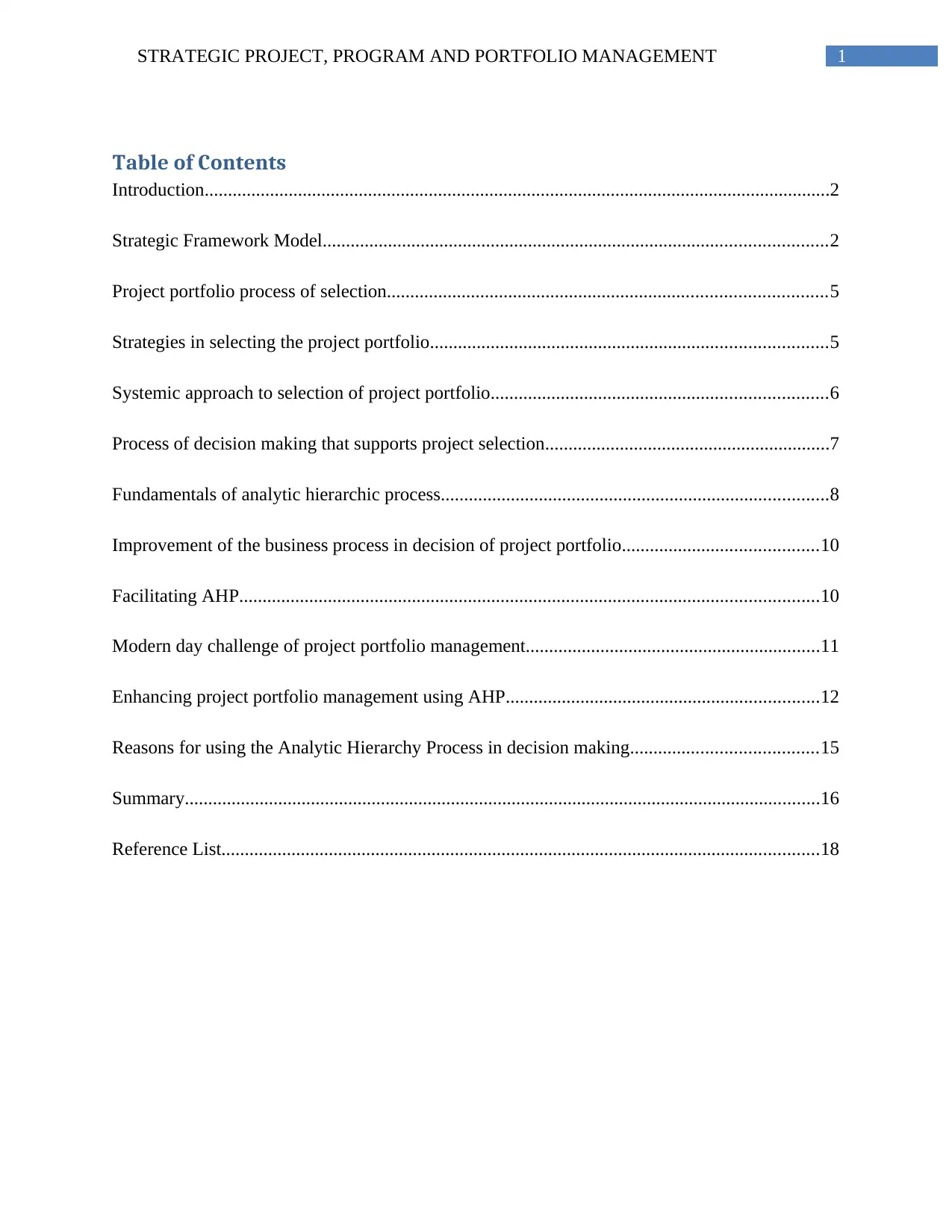
1STRATEGIC PROJECT, PROGRAM AND PORTFOLIO MANAGEMENT
Table of Contents
Introduction......................................................................................................................................2
Strategic Framework Model............................................................................................................2
Project portfolio process of selection..............................................................................................5
Strategies in selecting the project portfolio.....................................................................................5
Systemic approach to selection of project portfolio........................................................................6
Process of decision making that supports project selection.............................................................7
Fundamentals of analytic hierarchic process...................................................................................8
Improvement of the business process in decision of project portfolio..........................................10
Facilitating AHP............................................................................................................................10
Modern day challenge of project portfolio management...............................................................11
Enhancing project portfolio management using AHP...................................................................12
Reasons for using the Analytic Hierarchy Process in decision making........................................15
Summary........................................................................................................................................16
Reference List................................................................................................................................18
Table of Contents
Introduction......................................................................................................................................2
Strategic Framework Model............................................................................................................2
Project portfolio process of selection..............................................................................................5
Strategies in selecting the project portfolio.....................................................................................5
Systemic approach to selection of project portfolio........................................................................6
Process of decision making that supports project selection.............................................................7
Fundamentals of analytic hierarchic process...................................................................................8
Improvement of the business process in decision of project portfolio..........................................10
Facilitating AHP............................................................................................................................10
Modern day challenge of project portfolio management...............................................................11
Enhancing project portfolio management using AHP...................................................................12
Reasons for using the Analytic Hierarchy Process in decision making........................................15
Summary........................................................................................................................................16
Reference List................................................................................................................................18
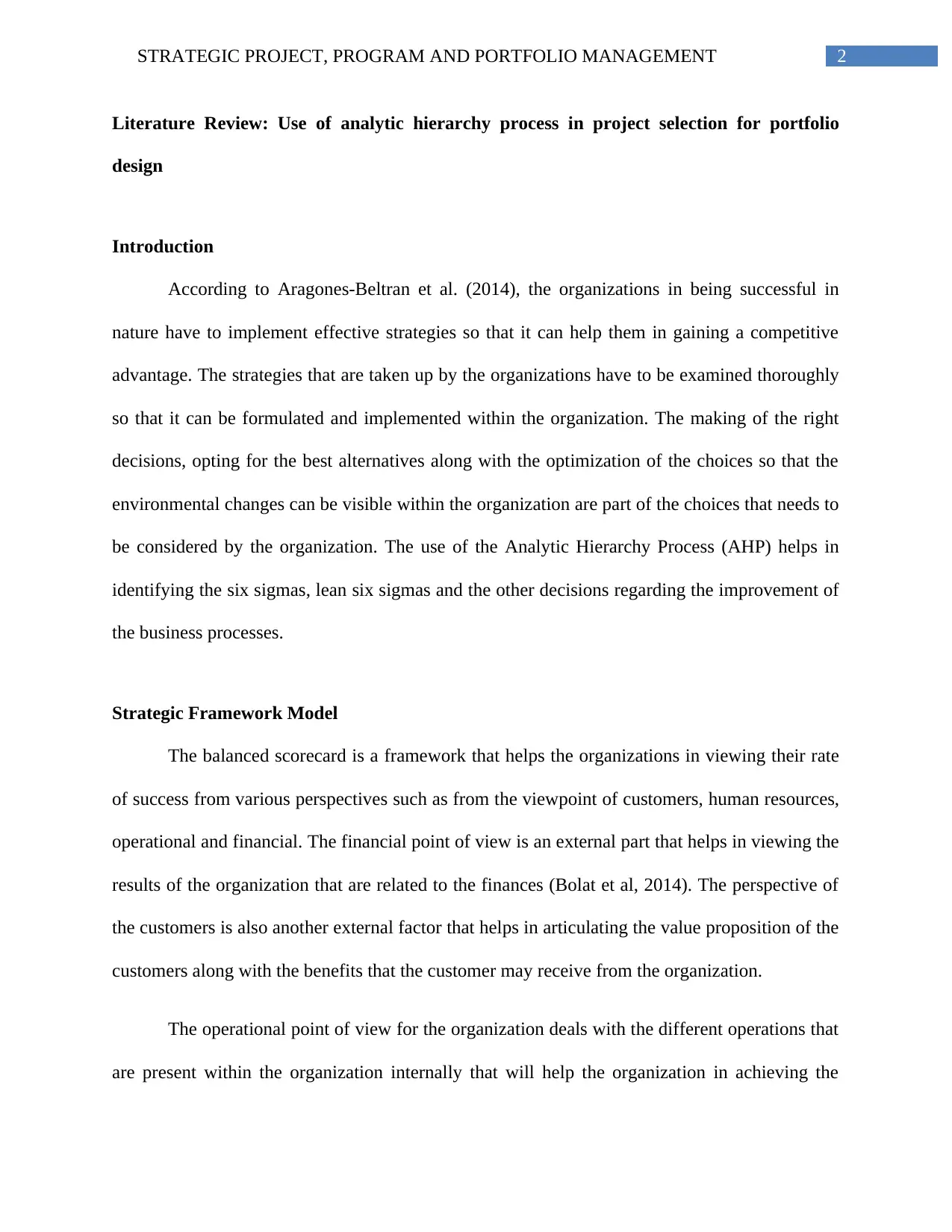
2STRATEGIC PROJECT, PROGRAM AND PORTFOLIO MANAGEMENT
Literature Review: Use of analytic hierarchy process in project selection for portfolio
design
Introduction
According to Aragones-Beltran et al. (2014), the organizations in being successful in
nature have to implement effective strategies so that it can help them in gaining a competitive
advantage. The strategies that are taken up by the organizations have to be examined thoroughly
so that it can be formulated and implemented within the organization. The making of the right
decisions, opting for the best alternatives along with the optimization of the choices so that the
environmental changes can be visible within the organization are part of the choices that needs to
be considered by the organization. The use of the Analytic Hierarchy Process (AHP) helps in
identifying the six sigmas, lean six sigmas and the other decisions regarding the improvement of
the business processes.
Strategic Framework Model
The balanced scorecard is a framework that helps the organizations in viewing their rate
of success from various perspectives such as from the viewpoint of customers, human resources,
operational and financial. The financial point of view is an external part that helps in viewing the
results of the organization that are related to the finances (Bolat et al, 2014). The perspective of
the customers is also another external factor that helps in articulating the value proposition of the
customers along with the benefits that the customer may receive from the organization.
The operational point of view for the organization deals with the different operations that
are present within the organization internally that will help the organization in achieving the
Literature Review: Use of analytic hierarchy process in project selection for portfolio
design
Introduction
According to Aragones-Beltran et al. (2014), the organizations in being successful in
nature have to implement effective strategies so that it can help them in gaining a competitive
advantage. The strategies that are taken up by the organizations have to be examined thoroughly
so that it can be formulated and implemented within the organization. The making of the right
decisions, opting for the best alternatives along with the optimization of the choices so that the
environmental changes can be visible within the organization are part of the choices that needs to
be considered by the organization. The use of the Analytic Hierarchy Process (AHP) helps in
identifying the six sigmas, lean six sigmas and the other decisions regarding the improvement of
the business processes.
Strategic Framework Model
The balanced scorecard is a framework that helps the organizations in viewing their rate
of success from various perspectives such as from the viewpoint of customers, human resources,
operational and financial. The financial point of view is an external part that helps in viewing the
results of the organization that are related to the finances (Bolat et al, 2014). The perspective of
the customers is also another external factor that helps in articulating the value proposition of the
customers along with the benefits that the customer may receive from the organization.
The operational point of view for the organization deals with the different operations that
are present within the organization internally that will help the organization in achieving the
⊘ This is a preview!⊘
Do you want full access?
Subscribe today to unlock all pages.

Trusted by 1+ million students worldwide
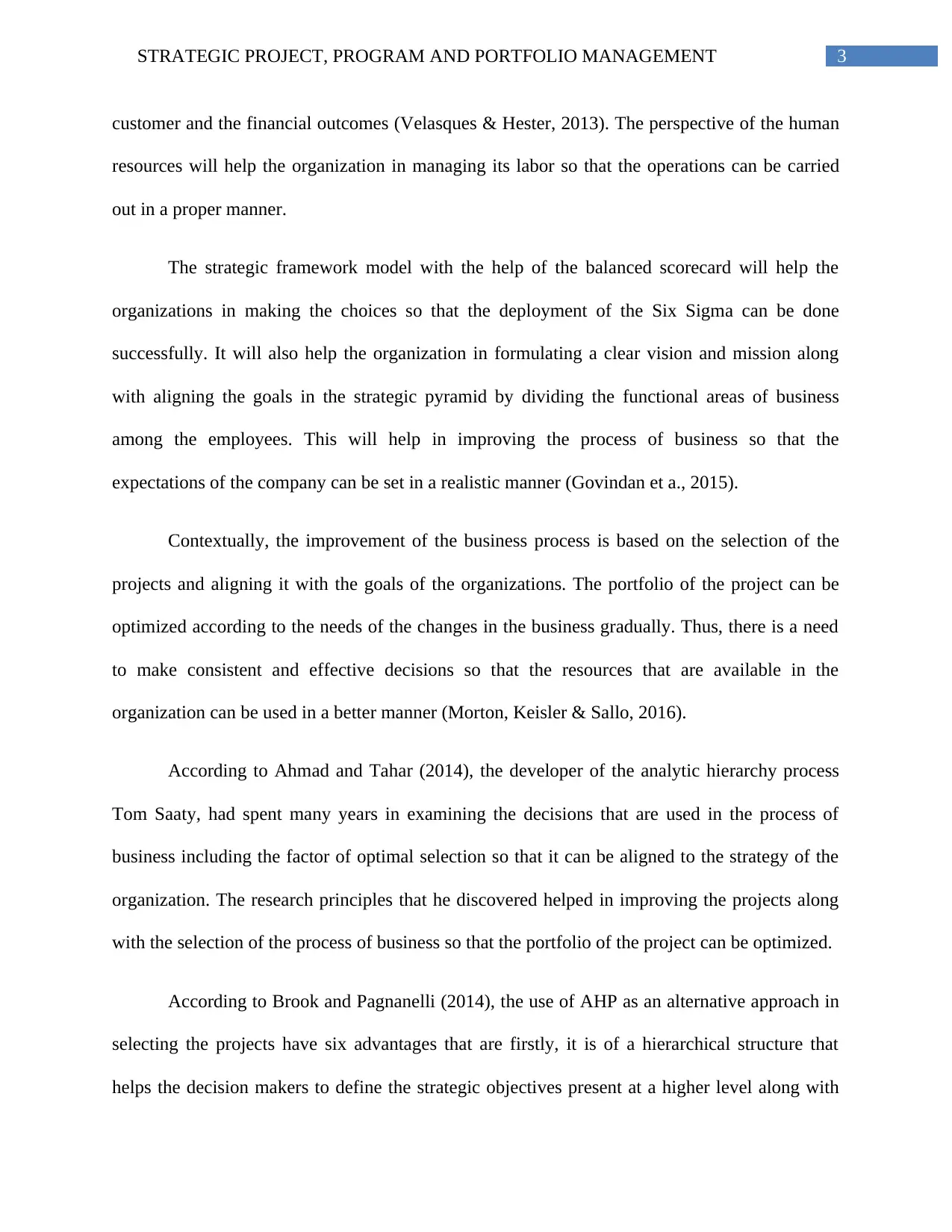
3STRATEGIC PROJECT, PROGRAM AND PORTFOLIO MANAGEMENT
customer and the financial outcomes (Velasques & Hester, 2013). The perspective of the human
resources will help the organization in managing its labor so that the operations can be carried
out in a proper manner.
The strategic framework model with the help of the balanced scorecard will help the
organizations in making the choices so that the deployment of the Six Sigma can be done
successfully. It will also help the organization in formulating a clear vision and mission along
with aligning the goals in the strategic pyramid by dividing the functional areas of business
among the employees. This will help in improving the process of business so that the
expectations of the company can be set in a realistic manner (Govindan et a., 2015).
Contextually, the improvement of the business process is based on the selection of the
projects and aligning it with the goals of the organizations. The portfolio of the project can be
optimized according to the needs of the changes in the business gradually. Thus, there is a need
to make consistent and effective decisions so that the resources that are available in the
organization can be used in a better manner (Morton, Keisler & Sallo, 2016).
According to Ahmad and Tahar (2014), the developer of the analytic hierarchy process
Tom Saaty, had spent many years in examining the decisions that are used in the process of
business including the factor of optimal selection so that it can be aligned to the strategy of the
organization. The research principles that he discovered helped in improving the projects along
with the selection of the process of business so that the portfolio of the project can be optimized.
According to Brook and Pagnanelli (2014), the use of AHP as an alternative approach in
selecting the projects have six advantages that are firstly, it is of a hierarchical structure that
helps the decision makers to define the strategic objectives present at a higher level along with
customer and the financial outcomes (Velasques & Hester, 2013). The perspective of the human
resources will help the organization in managing its labor so that the operations can be carried
out in a proper manner.
The strategic framework model with the help of the balanced scorecard will help the
organizations in making the choices so that the deployment of the Six Sigma can be done
successfully. It will also help the organization in formulating a clear vision and mission along
with aligning the goals in the strategic pyramid by dividing the functional areas of business
among the employees. This will help in improving the process of business so that the
expectations of the company can be set in a realistic manner (Govindan et a., 2015).
Contextually, the improvement of the business process is based on the selection of the
projects and aligning it with the goals of the organizations. The portfolio of the project can be
optimized according to the needs of the changes in the business gradually. Thus, there is a need
to make consistent and effective decisions so that the resources that are available in the
organization can be used in a better manner (Morton, Keisler & Sallo, 2016).
According to Ahmad and Tahar (2014), the developer of the analytic hierarchy process
Tom Saaty, had spent many years in examining the decisions that are used in the process of
business including the factor of optimal selection so that it can be aligned to the strategy of the
organization. The research principles that he discovered helped in improving the projects along
with the selection of the process of business so that the portfolio of the project can be optimized.
According to Brook and Pagnanelli (2014), the use of AHP as an alternative approach in
selecting the projects have six advantages that are firstly, it is of a hierarchical structure that
helps the decision makers to define the strategic objectives present at a higher level along with
Paraphrase This Document
Need a fresh take? Get an instant paraphrase of this document with our AI Paraphraser
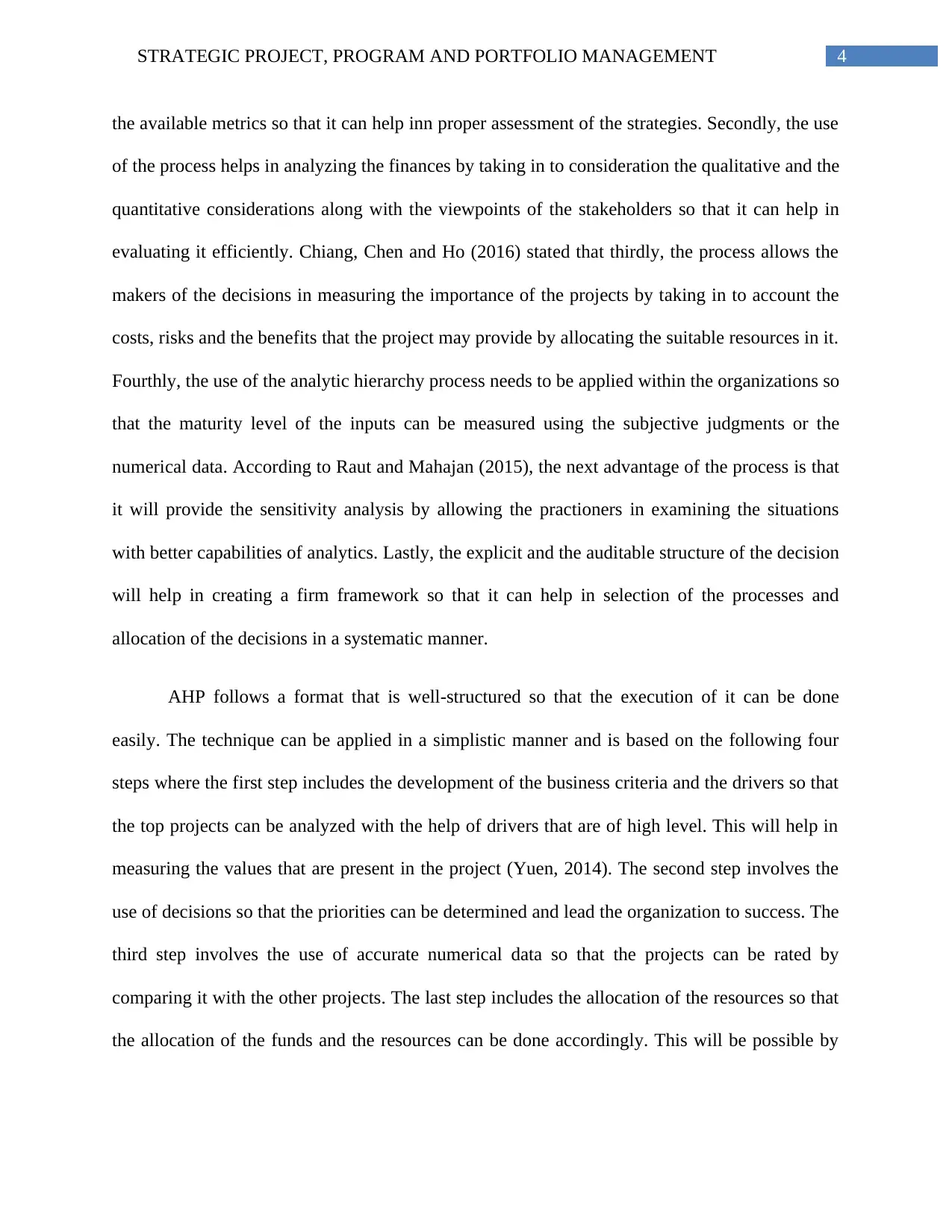
4STRATEGIC PROJECT, PROGRAM AND PORTFOLIO MANAGEMENT
the available metrics so that it can help inn proper assessment of the strategies. Secondly, the use
of the process helps in analyzing the finances by taking in to consideration the qualitative and the
quantitative considerations along with the viewpoints of the stakeholders so that it can help in
evaluating it efficiently. Chiang, Chen and Ho (2016) stated that thirdly, the process allows the
makers of the decisions in measuring the importance of the projects by taking in to account the
costs, risks and the benefits that the project may provide by allocating the suitable resources in it.
Fourthly, the use of the analytic hierarchy process needs to be applied within the organizations so
that the maturity level of the inputs can be measured using the subjective judgments or the
numerical data. According to Raut and Mahajan (2015), the next advantage of the process is that
it will provide the sensitivity analysis by allowing the practioners in examining the situations
with better capabilities of analytics. Lastly, the explicit and the auditable structure of the decision
will help in creating a firm framework so that it can help in selection of the processes and
allocation of the decisions in a systematic manner.
AHP follows a format that is well-structured so that the execution of it can be done
easily. The technique can be applied in a simplistic manner and is based on the following four
steps where the first step includes the development of the business criteria and the drivers so that
the top projects can be analyzed with the help of drivers that are of high level. This will help in
measuring the values that are present in the project (Yuen, 2014). The second step involves the
use of decisions so that the priorities can be determined and lead the organization to success. The
third step involves the use of accurate numerical data so that the projects can be rated by
comparing it with the other projects. The last step includes the allocation of the resources so that
the allocation of the funds and the resources can be done accordingly. This will be possible by
the available metrics so that it can help inn proper assessment of the strategies. Secondly, the use
of the process helps in analyzing the finances by taking in to consideration the qualitative and the
quantitative considerations along with the viewpoints of the stakeholders so that it can help in
evaluating it efficiently. Chiang, Chen and Ho (2016) stated that thirdly, the process allows the
makers of the decisions in measuring the importance of the projects by taking in to account the
costs, risks and the benefits that the project may provide by allocating the suitable resources in it.
Fourthly, the use of the analytic hierarchy process needs to be applied within the organizations so
that the maturity level of the inputs can be measured using the subjective judgments or the
numerical data. According to Raut and Mahajan (2015), the next advantage of the process is that
it will provide the sensitivity analysis by allowing the practioners in examining the situations
with better capabilities of analytics. Lastly, the explicit and the auditable structure of the decision
will help in creating a firm framework so that it can help in selection of the processes and
allocation of the decisions in a systematic manner.
AHP follows a format that is well-structured so that the execution of it can be done
easily. The technique can be applied in a simplistic manner and is based on the following four
steps where the first step includes the development of the business criteria and the drivers so that
the top projects can be analyzed with the help of drivers that are of high level. This will help in
measuring the values that are present in the project (Yuen, 2014). The second step involves the
use of decisions so that the priorities can be determined and lead the organization to success. The
third step involves the use of accurate numerical data so that the projects can be rated by
comparing it with the other projects. The last step includes the allocation of the resources so that
the allocation of the funds and the resources can be done accordingly. This will be possible by
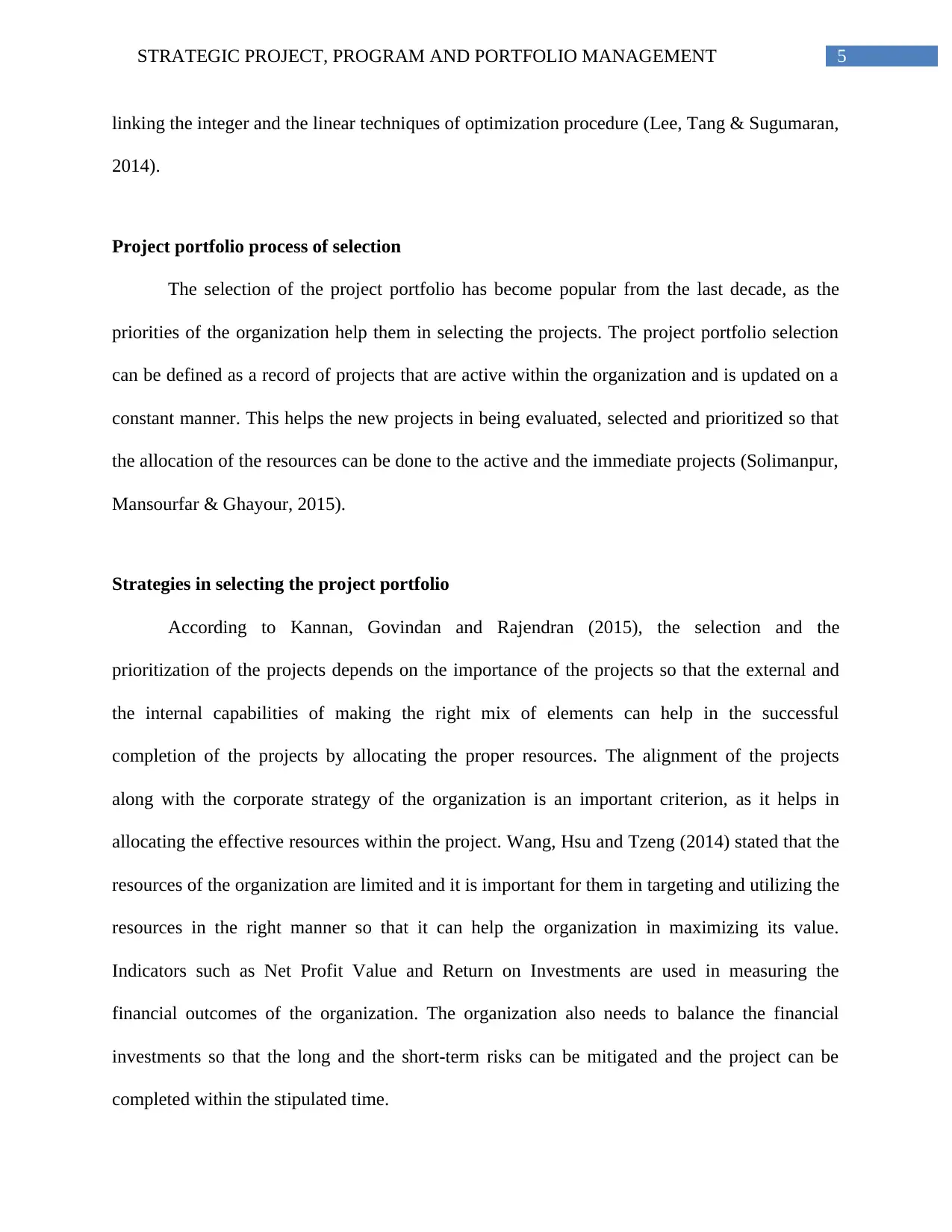
5STRATEGIC PROJECT, PROGRAM AND PORTFOLIO MANAGEMENT
linking the integer and the linear techniques of optimization procedure (Lee, Tang & Sugumaran,
2014).
Project portfolio process of selection
The selection of the project portfolio has become popular from the last decade, as the
priorities of the organization help them in selecting the projects. The project portfolio selection
can be defined as a record of projects that are active within the organization and is updated on a
constant manner. This helps the new projects in being evaluated, selected and prioritized so that
the allocation of the resources can be done to the active and the immediate projects (Solimanpur,
Mansourfar & Ghayour, 2015).
Strategies in selecting the project portfolio
According to Kannan, Govindan and Rajendran (2015), the selection and the
prioritization of the projects depends on the importance of the projects so that the external and
the internal capabilities of making the right mix of elements can help in the successful
completion of the projects by allocating the proper resources. The alignment of the projects
along with the corporate strategy of the organization is an important criterion, as it helps in
allocating the effective resources within the project. Wang, Hsu and Tzeng (2014) stated that the
resources of the organization are limited and it is important for them in targeting and utilizing the
resources in the right manner so that it can help the organization in maximizing its value.
Indicators such as Net Profit Value and Return on Investments are used in measuring the
financial outcomes of the organization. The organization also needs to balance the financial
investments so that the long and the short-term risks can be mitigated and the project can be
completed within the stipulated time.
linking the integer and the linear techniques of optimization procedure (Lee, Tang & Sugumaran,
2014).
Project portfolio process of selection
The selection of the project portfolio has become popular from the last decade, as the
priorities of the organization help them in selecting the projects. The project portfolio selection
can be defined as a record of projects that are active within the organization and is updated on a
constant manner. This helps the new projects in being evaluated, selected and prioritized so that
the allocation of the resources can be done to the active and the immediate projects (Solimanpur,
Mansourfar & Ghayour, 2015).
Strategies in selecting the project portfolio
According to Kannan, Govindan and Rajendran (2015), the selection and the
prioritization of the projects depends on the importance of the projects so that the external and
the internal capabilities of making the right mix of elements can help in the successful
completion of the projects by allocating the proper resources. The alignment of the projects
along with the corporate strategy of the organization is an important criterion, as it helps in
allocating the effective resources within the project. Wang, Hsu and Tzeng (2014) stated that the
resources of the organization are limited and it is important for them in targeting and utilizing the
resources in the right manner so that it can help the organization in maximizing its value.
Indicators such as Net Profit Value and Return on Investments are used in measuring the
financial outcomes of the organization. The organization also needs to balance the financial
investments so that the long and the short-term risks can be mitigated and the project can be
completed within the stipulated time.
⊘ This is a preview!⊘
Do you want full access?
Subscribe today to unlock all pages.

Trusted by 1+ million students worldwide
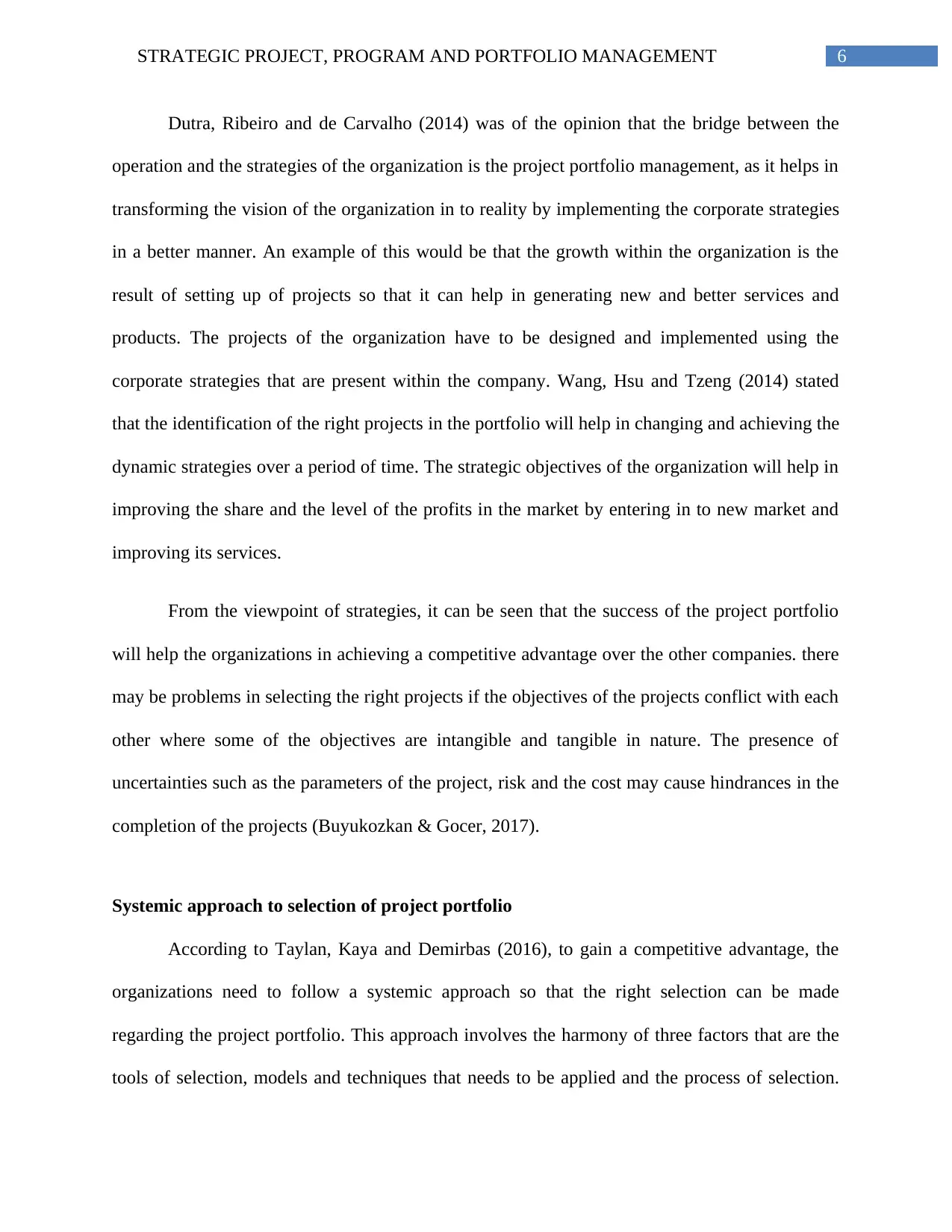
6STRATEGIC PROJECT, PROGRAM AND PORTFOLIO MANAGEMENT
Dutra, Ribeiro and de Carvalho (2014) was of the opinion that the bridge between the
operation and the strategies of the organization is the project portfolio management, as it helps in
transforming the vision of the organization in to reality by implementing the corporate strategies
in a better manner. An example of this would be that the growth within the organization is the
result of setting up of projects so that it can help in generating new and better services and
products. The projects of the organization have to be designed and implemented using the
corporate strategies that are present within the company. Wang, Hsu and Tzeng (2014) stated
that the identification of the right projects in the portfolio will help in changing and achieving the
dynamic strategies over a period of time. The strategic objectives of the organization will help in
improving the share and the level of the profits in the market by entering in to new market and
improving its services.
From the viewpoint of strategies, it can be seen that the success of the project portfolio
will help the organizations in achieving a competitive advantage over the other companies. there
may be problems in selecting the right projects if the objectives of the projects conflict with each
other where some of the objectives are intangible and tangible in nature. The presence of
uncertainties such as the parameters of the project, risk and the cost may cause hindrances in the
completion of the projects (Buyukozkan & Gocer, 2017).
Systemic approach to selection of project portfolio
According to Taylan, Kaya and Demirbas (2016), to gain a competitive advantage, the
organizations need to follow a systemic approach so that the right selection can be made
regarding the project portfolio. This approach involves the harmony of three factors that are the
tools of selection, models and techniques that needs to be applied and the process of selection.
Dutra, Ribeiro and de Carvalho (2014) was of the opinion that the bridge between the
operation and the strategies of the organization is the project portfolio management, as it helps in
transforming the vision of the organization in to reality by implementing the corporate strategies
in a better manner. An example of this would be that the growth within the organization is the
result of setting up of projects so that it can help in generating new and better services and
products. The projects of the organization have to be designed and implemented using the
corporate strategies that are present within the company. Wang, Hsu and Tzeng (2014) stated
that the identification of the right projects in the portfolio will help in changing and achieving the
dynamic strategies over a period of time. The strategic objectives of the organization will help in
improving the share and the level of the profits in the market by entering in to new market and
improving its services.
From the viewpoint of strategies, it can be seen that the success of the project portfolio
will help the organizations in achieving a competitive advantage over the other companies. there
may be problems in selecting the right projects if the objectives of the projects conflict with each
other where some of the objectives are intangible and tangible in nature. The presence of
uncertainties such as the parameters of the project, risk and the cost may cause hindrances in the
completion of the projects (Buyukozkan & Gocer, 2017).
Systemic approach to selection of project portfolio
According to Taylan, Kaya and Demirbas (2016), to gain a competitive advantage, the
organizations need to follow a systemic approach so that the right selection can be made
regarding the project portfolio. This approach involves the harmony of three factors that are the
tools of selection, models and techniques that needs to be applied and the process of selection.
Paraphrase This Document
Need a fresh take? Get an instant paraphrase of this document with our AI Paraphraser
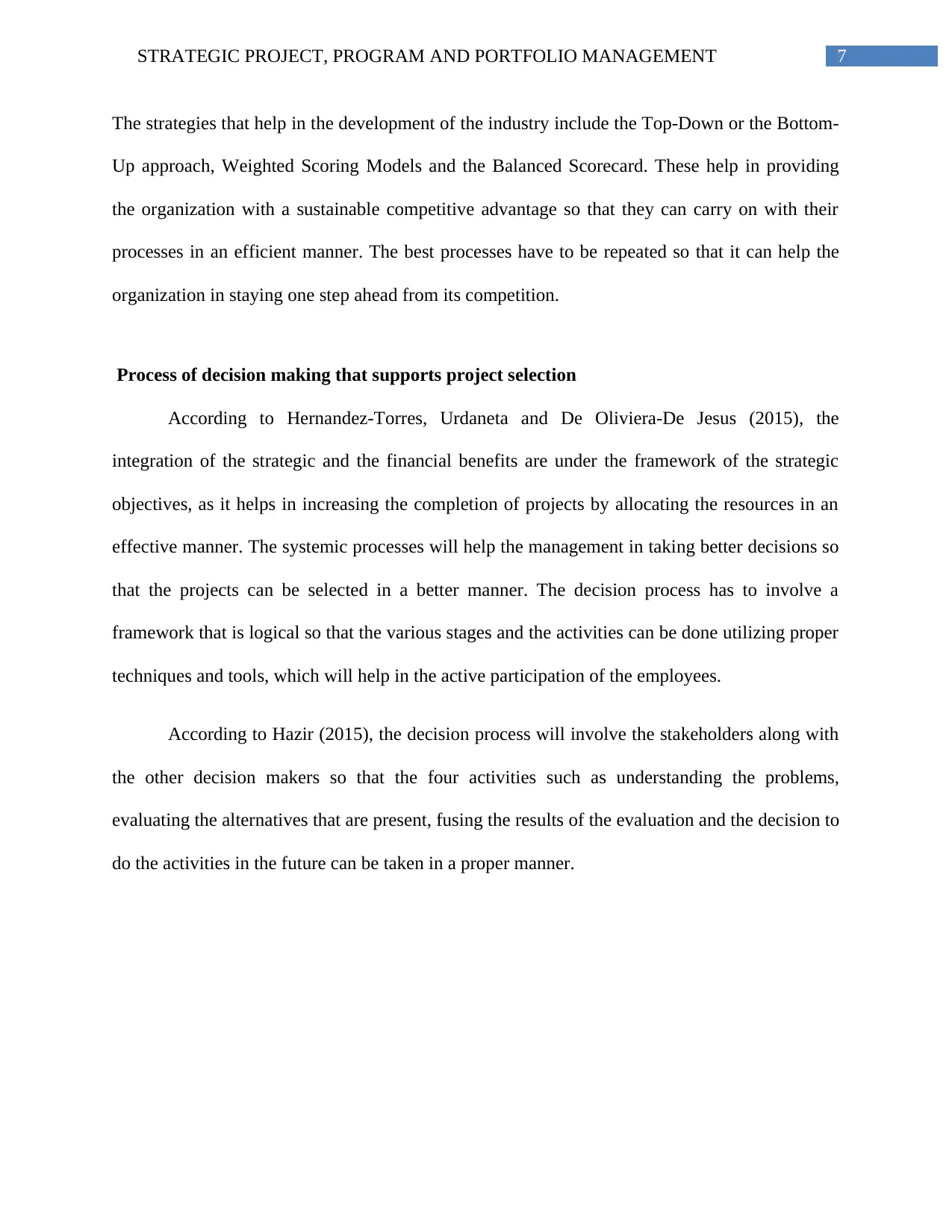
7STRATEGIC PROJECT, PROGRAM AND PORTFOLIO MANAGEMENT
The strategies that help in the development of the industry include the Top-Down or the Bottom-
Up approach, Weighted Scoring Models and the Balanced Scorecard. These help in providing
the organization with a sustainable competitive advantage so that they can carry on with their
processes in an efficient manner. The best processes have to be repeated so that it can help the
organization in staying one step ahead from its competition.
Process of decision making that supports project selection
According to Hernandez-Torres, Urdaneta and De Oliviera-De Jesus (2015), the
integration of the strategic and the financial benefits are under the framework of the strategic
objectives, as it helps in increasing the completion of projects by allocating the resources in an
effective manner. The systemic processes will help the management in taking better decisions so
that the projects can be selected in a better manner. The decision process has to involve a
framework that is logical so that the various stages and the activities can be done utilizing proper
techniques and tools, which will help in the active participation of the employees.
According to Hazir (2015), the decision process will involve the stakeholders along with
the other decision makers so that the four activities such as understanding the problems,
evaluating the alternatives that are present, fusing the results of the evaluation and the decision to
do the activities in the future can be taken in a proper manner.
The strategies that help in the development of the industry include the Top-Down or the Bottom-
Up approach, Weighted Scoring Models and the Balanced Scorecard. These help in providing
the organization with a sustainable competitive advantage so that they can carry on with their
processes in an efficient manner. The best processes have to be repeated so that it can help the
organization in staying one step ahead from its competition.
Process of decision making that supports project selection
According to Hernandez-Torres, Urdaneta and De Oliviera-De Jesus (2015), the
integration of the strategic and the financial benefits are under the framework of the strategic
objectives, as it helps in increasing the completion of projects by allocating the resources in an
effective manner. The systemic processes will help the management in taking better decisions so
that the projects can be selected in a better manner. The decision process has to involve a
framework that is logical so that the various stages and the activities can be done utilizing proper
techniques and tools, which will help in the active participation of the employees.
According to Hazir (2015), the decision process will involve the stakeholders along with
the other decision makers so that the four activities such as understanding the problems,
evaluating the alternatives that are present, fusing the results of the evaluation and the decision to
do the activities in the future can be taken in a proper manner.
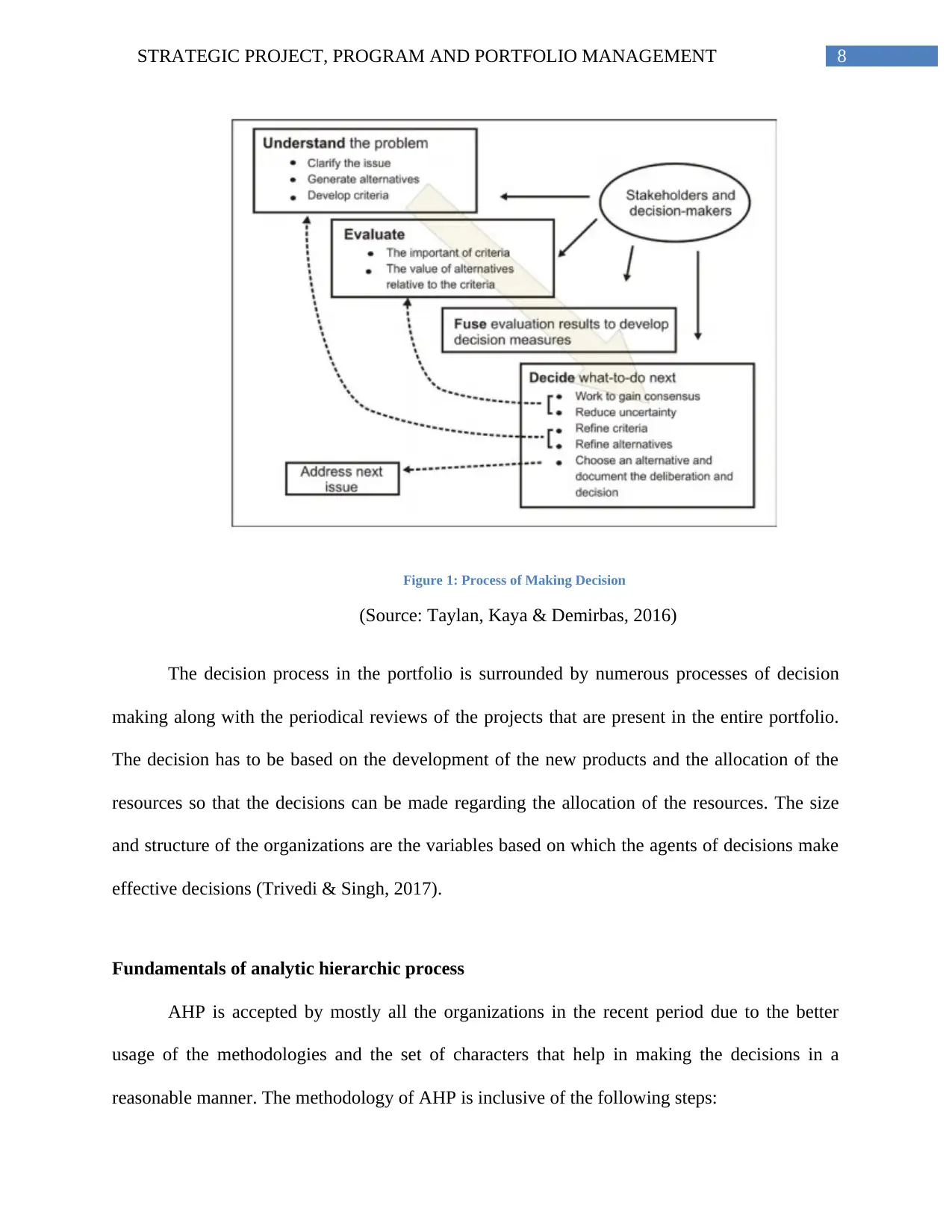
8STRATEGIC PROJECT, PROGRAM AND PORTFOLIO MANAGEMENT
Figure 1: Process of Making Decision
(Source: Taylan, Kaya & Demirbas, 2016)
The decision process in the portfolio is surrounded by numerous processes of decision
making along with the periodical reviews of the projects that are present in the entire portfolio.
The decision has to be based on the development of the new products and the allocation of the
resources so that the decisions can be made regarding the allocation of the resources. The size
and structure of the organizations are the variables based on which the agents of decisions make
effective decisions (Trivedi & Singh, 2017).
Fundamentals of analytic hierarchic process
AHP is accepted by mostly all the organizations in the recent period due to the better
usage of the methodologies and the set of characters that help in making the decisions in a
reasonable manner. The methodology of AHP is inclusive of the following steps:
Figure 1: Process of Making Decision
(Source: Taylan, Kaya & Demirbas, 2016)
The decision process in the portfolio is surrounded by numerous processes of decision
making along with the periodical reviews of the projects that are present in the entire portfolio.
The decision has to be based on the development of the new products and the allocation of the
resources so that the decisions can be made regarding the allocation of the resources. The size
and structure of the organizations are the variables based on which the agents of decisions make
effective decisions (Trivedi & Singh, 2017).
Fundamentals of analytic hierarchic process
AHP is accepted by mostly all the organizations in the recent period due to the better
usage of the methodologies and the set of characters that help in making the decisions in a
reasonable manner. The methodology of AHP is inclusive of the following steps:
⊘ This is a preview!⊘
Do you want full access?
Subscribe today to unlock all pages.

Trusted by 1+ million students worldwide
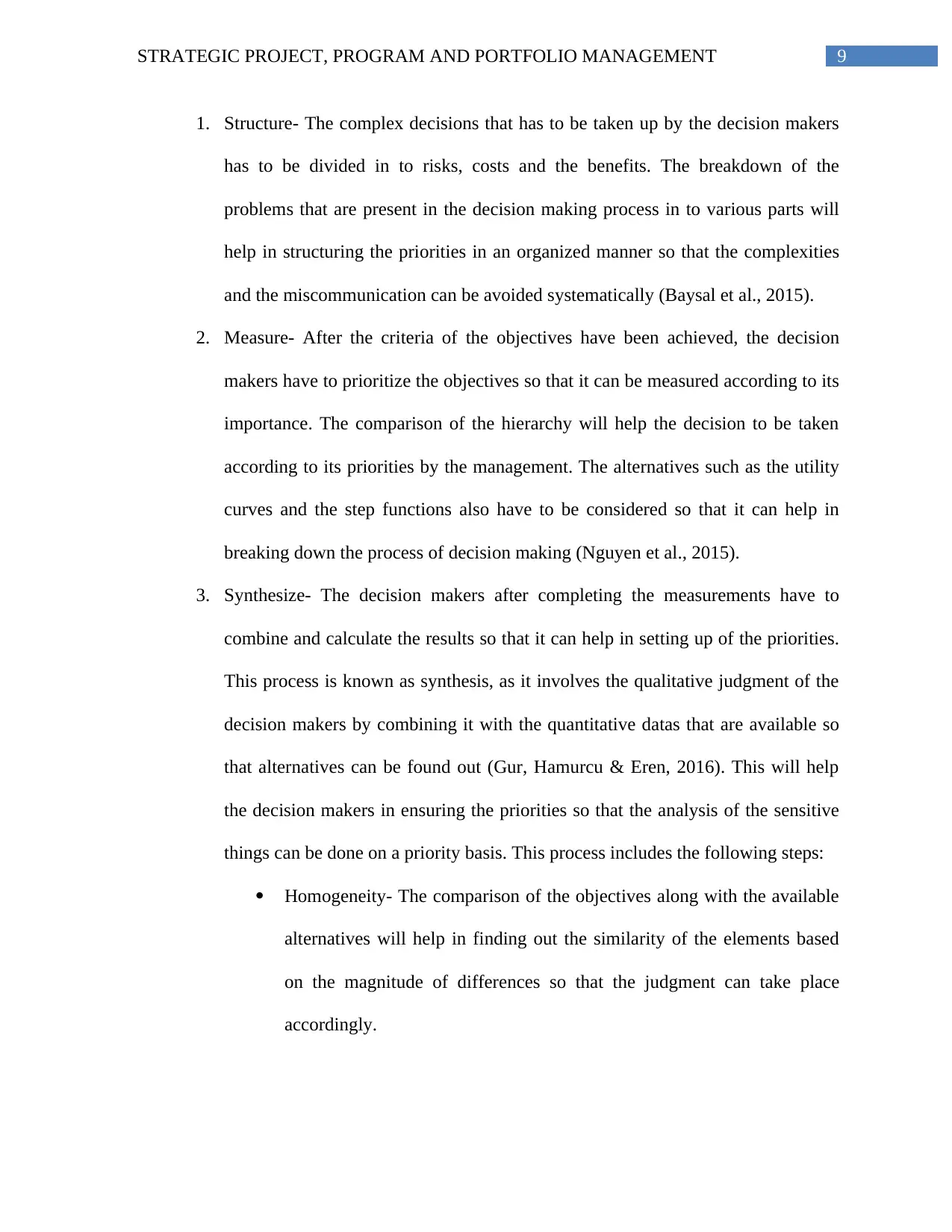
9STRATEGIC PROJECT, PROGRAM AND PORTFOLIO MANAGEMENT
1. Structure- The complex decisions that has to be taken up by the decision makers
has to be divided in to risks, costs and the benefits. The breakdown of the
problems that are present in the decision making process in to various parts will
help in structuring the priorities in an organized manner so that the complexities
and the miscommunication can be avoided systematically (Baysal et al., 2015).
2. Measure- After the criteria of the objectives have been achieved, the decision
makers have to prioritize the objectives so that it can be measured according to its
importance. The comparison of the hierarchy will help the decision to be taken
according to its priorities by the management. The alternatives such as the utility
curves and the step functions also have to be considered so that it can help in
breaking down the process of decision making (Nguyen et al., 2015).
3. Synthesize- The decision makers after completing the measurements have to
combine and calculate the results so that it can help in setting up of the priorities.
This process is known as synthesis, as it involves the qualitative judgment of the
decision makers by combining it with the quantitative datas that are available so
that alternatives can be found out (Gur, Hamurcu & Eren, 2016). This will help
the decision makers in ensuring the priorities so that the analysis of the sensitive
things can be done on a priority basis. This process includes the following steps:
Homogeneity- The comparison of the objectives along with the available
alternatives will help in finding out the similarity of the elements based
on the magnitude of differences so that the judgment can take place
accordingly.
1. Structure- The complex decisions that has to be taken up by the decision makers
has to be divided in to risks, costs and the benefits. The breakdown of the
problems that are present in the decision making process in to various parts will
help in structuring the priorities in an organized manner so that the complexities
and the miscommunication can be avoided systematically (Baysal et al., 2015).
2. Measure- After the criteria of the objectives have been achieved, the decision
makers have to prioritize the objectives so that it can be measured according to its
importance. The comparison of the hierarchy will help the decision to be taken
according to its priorities by the management. The alternatives such as the utility
curves and the step functions also have to be considered so that it can help in
breaking down the process of decision making (Nguyen et al., 2015).
3. Synthesize- The decision makers after completing the measurements have to
combine and calculate the results so that it can help in setting up of the priorities.
This process is known as synthesis, as it involves the qualitative judgment of the
decision makers by combining it with the quantitative datas that are available so
that alternatives can be found out (Gur, Hamurcu & Eren, 2016). This will help
the decision makers in ensuring the priorities so that the analysis of the sensitive
things can be done on a priority basis. This process includes the following steps:
Homogeneity- The comparison of the objectives along with the available
alternatives will help in finding out the similarity of the elements based
on the magnitude of differences so that the judgment can take place
accordingly.
Paraphrase This Document
Need a fresh take? Get an instant paraphrase of this document with our AI Paraphraser
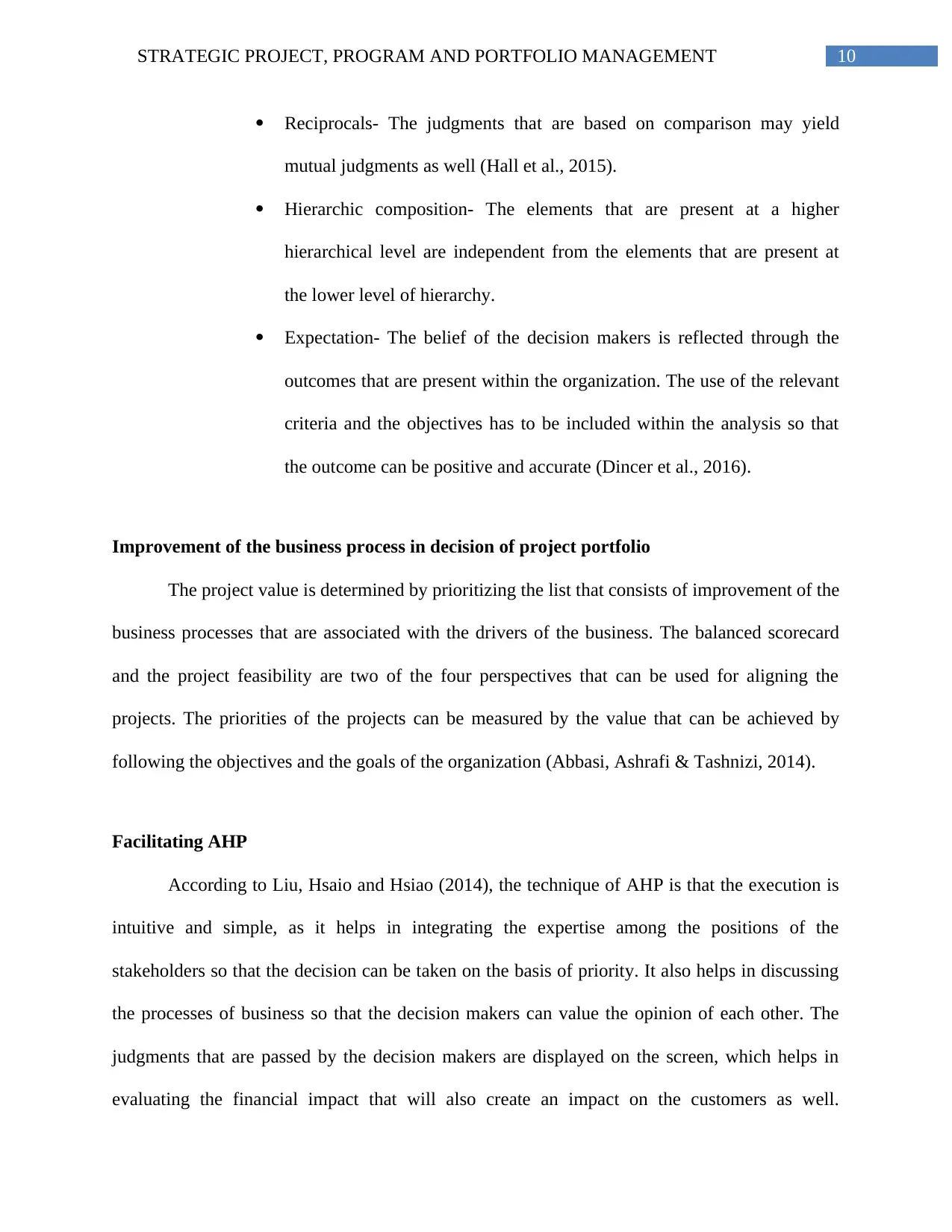
10STRATEGIC PROJECT, PROGRAM AND PORTFOLIO MANAGEMENT
Reciprocals- The judgments that are based on comparison may yield
mutual judgments as well (Hall et al., 2015).
Hierarchic composition- The elements that are present at a higher
hierarchical level are independent from the elements that are present at
the lower level of hierarchy.
Expectation- The belief of the decision makers is reflected through the
outcomes that are present within the organization. The use of the relevant
criteria and the objectives has to be included within the analysis so that
the outcome can be positive and accurate (Dincer et al., 2016).
Improvement of the business process in decision of project portfolio
The project value is determined by prioritizing the list that consists of improvement of the
business processes that are associated with the drivers of the business. The balanced scorecard
and the project feasibility are two of the four perspectives that can be used for aligning the
projects. The priorities of the projects can be measured by the value that can be achieved by
following the objectives and the goals of the organization (Abbasi, Ashrafi & Tashnizi, 2014).
Facilitating AHP
According to Liu, Hsaio and Hsiao (2014), the technique of AHP is that the execution is
intuitive and simple, as it helps in integrating the expertise among the positions of the
stakeholders so that the decision can be taken on the basis of priority. It also helps in discussing
the processes of business so that the decision makers can value the opinion of each other. The
judgments that are passed by the decision makers are displayed on the screen, which helps in
evaluating the financial impact that will also create an impact on the customers as well.
Reciprocals- The judgments that are based on comparison may yield
mutual judgments as well (Hall et al., 2015).
Hierarchic composition- The elements that are present at a higher
hierarchical level are independent from the elements that are present at
the lower level of hierarchy.
Expectation- The belief of the decision makers is reflected through the
outcomes that are present within the organization. The use of the relevant
criteria and the objectives has to be included within the analysis so that
the outcome can be positive and accurate (Dincer et al., 2016).
Improvement of the business process in decision of project portfolio
The project value is determined by prioritizing the list that consists of improvement of the
business processes that are associated with the drivers of the business. The balanced scorecard
and the project feasibility are two of the four perspectives that can be used for aligning the
projects. The priorities of the projects can be measured by the value that can be achieved by
following the objectives and the goals of the organization (Abbasi, Ashrafi & Tashnizi, 2014).
Facilitating AHP
According to Liu, Hsaio and Hsiao (2014), the technique of AHP is that the execution is
intuitive and simple, as it helps in integrating the expertise among the positions of the
stakeholders so that the decision can be taken on the basis of priority. It also helps in discussing
the processes of business so that the decision makers can value the opinion of each other. The
judgments that are passed by the decision makers are displayed on the screen, which helps in
evaluating the financial impact that will also create an impact on the customers as well.
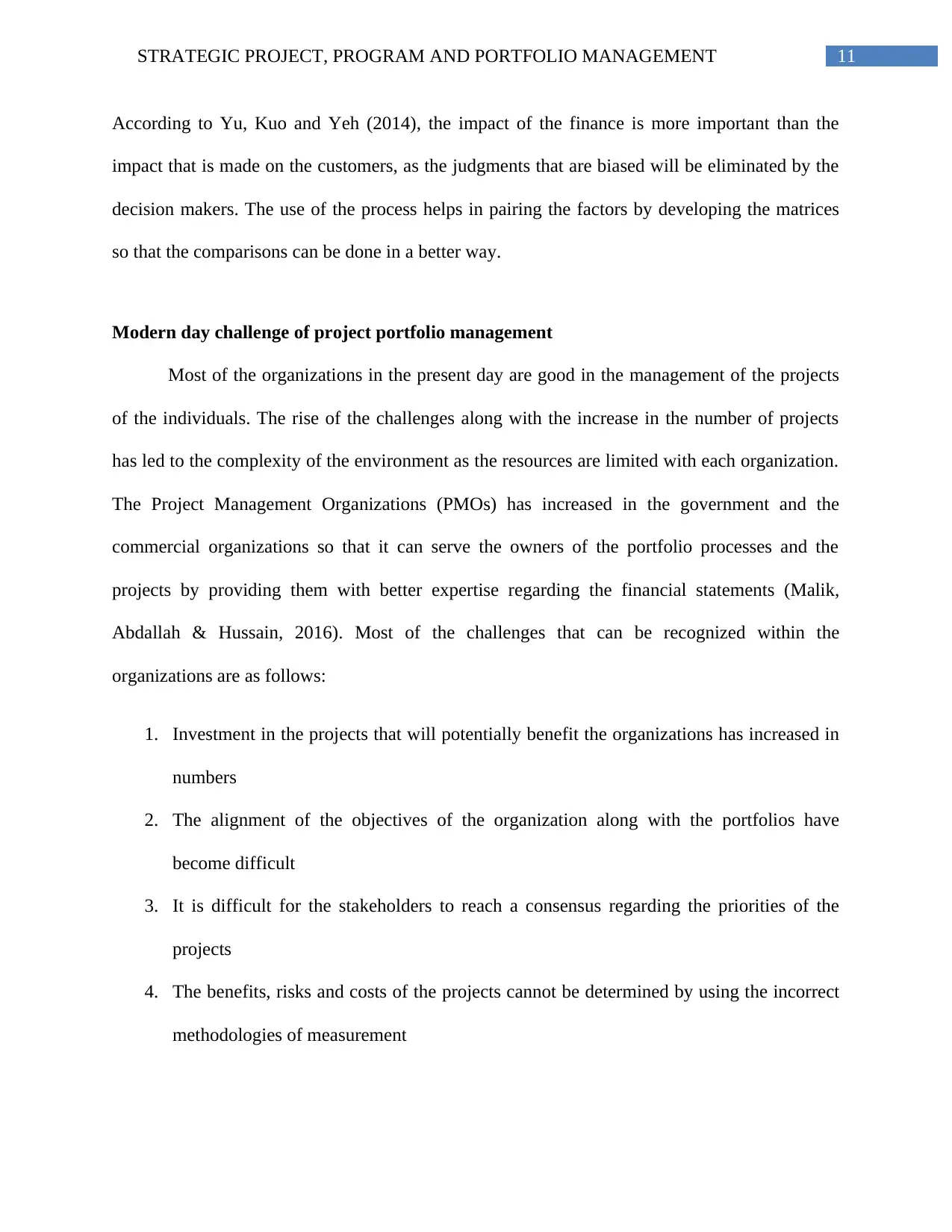
11STRATEGIC PROJECT, PROGRAM AND PORTFOLIO MANAGEMENT
According to Yu, Kuo and Yeh (2014), the impact of the finance is more important than the
impact that is made on the customers, as the judgments that are biased will be eliminated by the
decision makers. The use of the process helps in pairing the factors by developing the matrices
so that the comparisons can be done in a better way.
Modern day challenge of project portfolio management
Most of the organizations in the present day are good in the management of the projects
of the individuals. The rise of the challenges along with the increase in the number of projects
has led to the complexity of the environment as the resources are limited with each organization.
The Project Management Organizations (PMOs) has increased in the government and the
commercial organizations so that it can serve the owners of the portfolio processes and the
projects by providing them with better expertise regarding the financial statements (Malik,
Abdallah & Hussain, 2016). Most of the challenges that can be recognized within the
organizations are as follows:
1. Investment in the projects that will potentially benefit the organizations has increased in
numbers
2. The alignment of the objectives of the organization along with the portfolios have
become difficult
3. It is difficult for the stakeholders to reach a consensus regarding the priorities of the
projects
4. The benefits, risks and costs of the projects cannot be determined by using the incorrect
methodologies of measurement
According to Yu, Kuo and Yeh (2014), the impact of the finance is more important than the
impact that is made on the customers, as the judgments that are biased will be eliminated by the
decision makers. The use of the process helps in pairing the factors by developing the matrices
so that the comparisons can be done in a better way.
Modern day challenge of project portfolio management
Most of the organizations in the present day are good in the management of the projects
of the individuals. The rise of the challenges along with the increase in the number of projects
has led to the complexity of the environment as the resources are limited with each organization.
The Project Management Organizations (PMOs) has increased in the government and the
commercial organizations so that it can serve the owners of the portfolio processes and the
projects by providing them with better expertise regarding the financial statements (Malik,
Abdallah & Hussain, 2016). Most of the challenges that can be recognized within the
organizations are as follows:
1. Investment in the projects that will potentially benefit the organizations has increased in
numbers
2. The alignment of the objectives of the organization along with the portfolios have
become difficult
3. It is difficult for the stakeholders to reach a consensus regarding the priorities of the
projects
4. The benefits, risks and costs of the projects cannot be determined by using the incorrect
methodologies of measurement
⊘ This is a preview!⊘
Do you want full access?
Subscribe today to unlock all pages.

Trusted by 1+ million students worldwide
1 out of 23
Related Documents
Your All-in-One AI-Powered Toolkit for Academic Success.
+13062052269
info@desklib.com
Available 24*7 on WhatsApp / Email
![[object Object]](/_next/static/media/star-bottom.7253800d.svg)
Unlock your academic potential
Copyright © 2020–2025 A2Z Services. All Rights Reserved. Developed and managed by ZUCOL.





